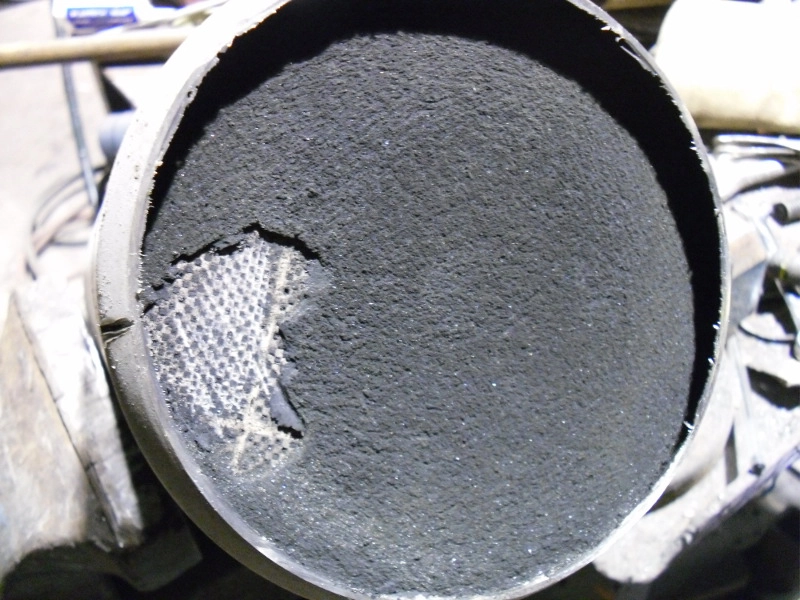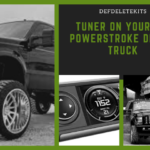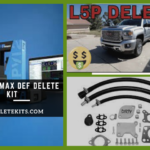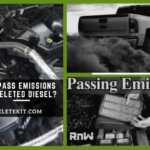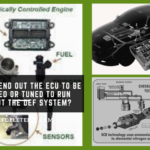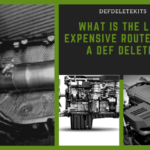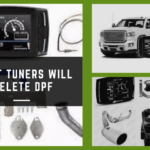DPF Delete 2024
In 2008 the EPA decided that Diesel trucks were killing the environment and the previously exempt and supreme engine type would not be forced to comply with the strict smog standards of gasoline engines. Well, they did it, by adding Diesel Particulate Filters to modern diesel, the issue is the laundry list of problems this new smog equipment causes and the expensive repair bills that come with them, avoid all of this with a DPF delete, below I have laid out the best DPF delete kits for your truck, no matter what modern Diesel you have we have the right delete kit for you.
DPF filters have been known to cause countless issues and the worst part is the issues generally start after your factory warranty. You will lose power which is the entire reason you bought a diesel in the first place, many Diesel owner-report their trucks going into limp mode as they are towing due to DPF complications. You will lose fuel economy which is the modern-day equivalent of setting money on fire, and no one likes that. So before this happens to you, let me show you the best DPF delete kits on the market.
It is a must that every vehicle owner should look for the right solution. By doing so, they can save time and money. DPF Delete should be done in appropriate progress. Make sure you spend your time checking our given list below.
2011-2015 -2016 Duramax LML DPF Delete
- Part Type: Cover Plate
- Mounting Style: Bolt-On
- Billet Aluminum, CNC Precision Machined
- Intake Resonator Cover and all hardware required for installation
- Compatible with 2011-2016 Chevy/GMC 6.6L LML Duramax Diesel 2500HD/3500HD
- Part Type: Cover Plate
- Mounting Style: Bolt-On
- Billet Aluminum, CNC Precision Machined
- Intake Resonator Cover and all hardware required for installation
- Compatible with 2011-2016 Chevy/GMC 6.6L LML Duramax Diesel 2500HD/3500HD
2007.5-2009 2010-2012 2013-2015 Cummins DPF Delete
- Designed to deliver trouble-free, consistent performance
- Right for your vehicle and lifestyle
- Made from high-quality materials for ultimate durability
- Manufactured to meet or exceed strict quality requirements
- The TopTekk TTB010 is the flagship product of our TTB series. It is compatible with 7 types of engines: Cummins, Caterpillar, Volvo, Paccar, Mack, Detroit, and International/Maxxforce.
- Restore Power and Enhance Performance The TopTekk TTB series is designed specifically for heavy-duty trucks, quickly clearing DPF blockages and restoring robust engine power. It addresses issues such as slow acceleration and reduced power, making your transportation more efficient
- Prerequisites and Operational Guidelines: When performing regeneration operations, it is imperative to ensure that the vehicle is completely stopped and the engine is maintained at idle speed. During this period, it is strictly prohibited to simultaneously activate the air conditioning or any other electrical equipment to ensure smooth operation and safety.
- Go Green and Stay Compliant: The TopTekk TTB series reduces black smoke emissions, ensuring compliance and greener travel. With optimized exhaust systems, it boosts fuel efficiency, cuts costs, and lowers emissions
- Convenient Operation, Time and Labor Saving:Supporting one-click operation on the mobile phone APP, you can manage and maintain anytime and anywhere to improve operational efficiency. Whether it is long-distance transportation or short-distance delivery, TopTekk TTB series is your most reliable partner
2008-2010-2011-2015 Powerstroke DPF Delete
No products found.
What Components Do You Need to Delete Your Truck?
#1Dashboard Tuner and Diagnostic Tool
The most important component is a high-quality tuner that will not throw error codes, we suggest the Dashboard Tuner and Diagnostic Tool
Diagnostic Tool
- 【Extensive Compatibility】After the upgrade, the compatibility is wider and more accurate! HD601 heavy duty truck scanner supports all major truck models that comply with standard protocols (SAE J1939, SAE J1708, ISO 14230-4, ISO 15764-4 and ISO 9141-2, ISO 27145-4 and Euro6). Fits for Cummins, Paccar, Detroit, Perkins, Freightliner, International, Peterbilt, Ford, Class 4-Class 8 trucks, etc. It also check engine diagnosis on most cars, minivans and light trucks
- 【 Full System Diagnostic】HD601 Diesel Scanner supports all system scans of heavy trucks compliant with standard protocols SAE J1939 & J1708, such as Engine, ABS, Transmission, Braking System, ESP, EPS, Fuel System, etc, It is a great scan tool fits for Cummins, Caterpillar, Detroit, Perkins, Maxxforce, Bendix,Wabash, Wabaco, Haldex, Allison, Eaton heavy trucks, With this truck tool, you can get deep analysis data about the system and do some repairs by yourself, saving much time and money.Note: Only heavy truck vehicles that comply with the above protocol can diagnose the entire system
- 【Enhanced Diesel OBD Scanner】The HD601 Diesel OBD Scanner offers unparalleled diagnostic capabilities for heavy-duty trucks. Beyond code reading, clearing, and live data display, it retrieves vehicle information, freeze frames, and DTCs. With 6, 9, and 16 pin cables, it ensures compatibility with various engines. This scanner's real-world testing prowess ensures comprehensive support for a wide array of heavy-duty truck engines, making it an indispensable tool for truck diagnostics
- 【DTC Library】+【Life Time Free Update】The built-in DTC library allows you to retrieve the codes directly without searching for the definition in the book. Whether you are a professional mechanic or a DIY car owner, HD601 diesel scanner explains the existing problem, makes it easier for you to understand the codes definition and fix the problem faster. Plus, you get a lifetime free internet updates, so you always have the latest software for diagnostics in English and Spanish languages
- 【Friendly Design, Easy of Use】This scanner is plug and play, simple and convenient, and very friendly for beginners. With improved buttons for easy menu navigation. The excellent 2.8 inch LCD color screen makes it easy to view the displayed results and gives you a better overview of your car's problem areas and the identified codes. In addition, the processor is super-fast and responds without lagging, providing maximum comfort and efficiency in diagnostic and service work.
- 12 Month Warranty
- Includes 9-pin, OBDII, & 6-pin connectors
- Includes 90-days of Diesel Repair Professional Subscription. Fault codes troubleshooting trees, wiring diagrams, labor time guides, & much more.
- Includes Diesel Explorer - View & Clear fault codes, view live data, download ECM reports, & more.
- Wired Edition (No Bluetooth or Wifi)
WHY USE A TUNER?
Whether you’re seeking that excess bit of power to the tow rig, or just attempting to get much better mileage, then a tuner/programmer ought to be next on your list. A mic communicates directly with your car/trucks personal pc through the OBD2 diagnostic interface and permits you to take charge of your trip.
The numerous adjustable features like speedometer correction, transmission change stage alteration, diagnostics, rate limiter removal/set, indicator tracking, and a lot more makes for the strongest tool available. The ease of setup takes away any uncertainty which you may have regarding whether a developer is ideal for you.
GT Platinum Diesel Diagnostic and Performance Tuner
The GT Platinum Card Diesel is four products in one; a car engine recorder, track, diagnostic and judge apparatus all in one unit. The GT radically boosts the usefulness of your car or truck by raising horsepower, enhancing fuel economy and supplying an extensive set of tracking attributes and diagnostic purposes. This item is incomparable to additional tuning goods since it’s the biggest attribute set along with the broadest assortment of vehicle programs from one product component number.
#2 DPF Delete Pipe & turbo back exhaust from MBRP
- 16 Gauge Aluminized Steel
- Welded On Hangers
- Tip Included (4" Systems)
- Built from heavy duty aluminized steel our Installer Series performance exhaust systems offer a value price without compromising on the quality built into every component.
An MBRP performance exhaust system will be the starting point to gaining the most out of cold air intakes, modules, programmers, and downloaders. Simple Setup MBRP systems have as much pleasure to install as to push on your truck. Bolt-on, no weld design makes setup a no-hassle and a half to 2-hour undertaking.
Everything is straight fit into the OEM hangers and you receive all the clamps and components you’ll need. Sound & Style Performance is 1 thing but at MBRP we believe that look and sound are just as important. Each MBRP performance exhaust system has been specifically tuned to get the perfect sound from the pickup. With our stamped logo on the suggestion and our unmistakable styling, there is no question that you have the latest performance exhaust on the street – MBRP.
#3 K&N Cold Air Intake S&B Filters
- GUARANTEED INCREASE IN HORSEPOWER & TORQUE: K&N cold air intake systems provide a less restrictive path for airflow, increasing the volume of cool, oxygen-rich air into your engine.
- DYNO TESTING YOU CAN TRUST: K&N air intake horsepower/torque testing is performed on wheel-based dynamometers and the reports are included with each intake system.
- IMPROVED ENGINE SOUND - HEAR THE GROWL: K&N’s intake systems allow your engine to breathe and sound as it should- your engine will growl on acceleration and return to quiet once at speed.
- BETTER TOWING: K&N Air intake kit improves acceleration and uphill performance when towing by improving throttle response, overall horsepower and torque. Excellent for daily and highway driving.
- PREMIUM ENGINE PROTECTION FROM A TRUSTED BRAND: K&N air intake will not void manufacturer vehicle warranty & No-Hassle Lifetime Limited Warranty protects for the life of your vehicle.
- GUARANTEED INCREASE IN HORSEPOWER & TORQUE: K&N cold air intake systems provide a less restrictive path for airflow, increasing the volume of cool, oxygen-rich air into your engine.
- DYNO TESTING YOU CAN TRUST: K&N air intake horsepower/torque testing is performed on wheel-based dynamometers and the reports are included with each intake system.
- IMPROVED ENGINE SOUND - HEAR THE GROWL: K&N’s intake systems allow your engine to breathe and sound as it should- your engine will growl on acceleration and return to quiet once at speed.
- BETTER TOWING: K&N Air intake kit improves acceleration and uphill performance when towing by improving throttle response, overall horsepower and torque. Excellent for daily and highway driving.
- PREMIUM ENGINE PROTECTION FROM A TRUSTED BRAND: K&N air intake will not void manufacturer vehicle warranty & No-Hassle Lifetime Limited Warranty protects for the life of your vehicle.
Although not necessary a Cold Air Intake will really boost performance and give you better MPG, We suggest the K&N Cold Air Intake & S&B Filters
According to Defdeletekits.com, obtaining the best cold air intake system has many benefits. These benefits include maximizing the power of your vehicle’s engine, a noticeable increase in horsepower, enhanced throttle response, advanced fuel economy, the durability of air filters, specialized engineering, and simple installation instructions.
A car’s engine relies on its mixture of air and fuel for combustion. Its intake tube and airbox are filled with air filters to help your car to obtain the air needed. The intake tube is designed to be as quiet as possible, and it should easily fit in the engine compartment. Because of the many turns and bends in the intake tube, smaller amounts of air are sent to the combustion chamber. This results in hot air being trapped inside and the hot air causes minimum power efficiency.
A car’s engine relies on its mixture of air and fuel for combustion. Its intake tube and airbox are filled with air filters to help your car to obtain air needed. The intake tube is designed to be as quiet as possible, and it should easily fit in the engine compartment. Because of the many turns and bends in the intake tube, smaller amounts of air are sent to the combustion chamber. This results in hot air being trapped inside and the hot air causes minimum power efficiency.
#4 EGR delete
When you do your DPF delete you will also need a high-quality EGR delete kit. This kit from Sinister Diesel is both affordable and high quality. Sinister Diesel has been providing top quality EGR block offs for years and they are the leader in performance diesel parts
The EGR might be good for reducing emissions on a standard truck, but it is a system that is prone to failure and even when working correctly hurts your overall engine power and efficiency. A Ford Powerstroke EGR delete kit 6.0 can bypass the entire system and let you run your truck the way it was meant to run.
The basic process of installing an EGR delete kit 6.0 involves first removing the air cleaner assembly, FICM module, and turbo intake tubes. From there, drain the coolant, and continue with removing the turbo, EGR valve, alternator, injector harness, and intake manifold.
Many of these parts, especially the intake manifold, are well-secured with multiple bolts and clips, so be sure you’re up to the task before attempting to remove so much of your engine. If you do decide to tackle this one your own, be very sure to keep all parts, bolts, and tubes properly separated and labeled so you can put them back later after installing your EGR delete kit 6.0!
DPF Delete for 2007.5-2010 6.6L GM Duramax LMM
If you’re looking for the absolute best parts for your LMM, this is it. The Performance Tuner, aFe Turbo Back Exhaust, S&B Cold Air Intake and CNS Engine Parts EGR Block Off Kit. With all of these parts your Duramax will have more power, better fuel economy and most importantly it won’t leave you stranded with a clogged DPF filter. Click on the images below for pricing and information:
DPF Delete for 2007.5-2009 6.7L Dodge Cummins
Don’t let your Cummins stop pulling! Delete your DPF filter today, boost HP, Torque and MPG. The 6.7 Cummins is an absolute beast but in stock form it’s a ticking time bomb. By opening up your exhaust and intake and blocking off your EGR you are giving your 6.7 the chance to run like it should, start rolling coal today! Click on the images below for pricing and information:
DPF Delete for 2013-2015 6.7L Dodge Cummins
Don’t let your Cummins stop pulling! Delete your DPF filter today, boost HP, Torque and MPG. The 6.7 Cummins is an absolute beast but in stock form it’s a ticking time bomb. By opening up your Delete Cummins Diesel exhaust and intake and blocking off your EGR you are giving your 6.7 the chance to run like it should, start rolling coal today! Click on the images below for pricing and information:
Cooler Delete Gaskets
amzn_assoc_placement = “adunit0”; amzn_assoc_tracking_id = “defdeletekit-20”; amzn_assoc_ad_mode = “manual”; amzn_assoc_ad_type = “smart”; amzn_assoc_marketplace = “amazon”; amzn_assoc_region = “US”; amzn_assoc_linkid = “750fc1285bf564116b09abf94795b8c6”; amzn_assoc_asins = “B081NWGRZR,B07ZZKK9C6,B004XONS9Y,B07DP3JMSV,B01N2LUVAF”; amzn_assoc_title = “My Amazon Picks”; amzn_assoc_search_bar = “true”;
If you are noticing engine oil in your coolant system, oil or coolant leaking from the oil cooler or engine coolant mixed with your engine oil then your oil cooler might need to be looked at or replaced. This engine oil cooler kit also includes viton gasket seals needed for the proper service on your vehicle.
DPF Delete for 2008-2010 6.4L Ford Powerstroke
No matter how you feel about the 6.4, Love it or Hate it, you cannot deny that it has been plagued with issues, most of them relating back to the DPF and EGR system. Save yourself thousands by being proactive and deleting your DPF and EGR, matched up with a Powerstroke Delete and the SB intake your 6.4L will be the envy of all of the 6.4 owners who didn’t delete their DPF in time. Click on the images below for pricing and information:
Powerstroke Delete
amzn_assoc_placement = “adunit0”; amzn_assoc_tracking_id = “defdeletekit-20”; amzn_assoc_ad_mode = “manual”; amzn_assoc_ad_type = “smart”; amzn_assoc_marketplace = “amazon”; amzn_assoc_region = “US”; amzn_assoc_linkid = “750fc1285bf564116b09abf94795b8c6”; amzn_assoc_asins = “B07SR5N8K1,B07D2881W2,B01MRLF23W,B076C43RDY,B07CNCPTN5,B071RS785S,B07DP3JMSV,B0753VG5YY,B0748Y14SM,B081NWGRZR”; amzn_assoc_title = “My Amazon Picks”; amzn_assoc_search_bar = “true”;
Installing SCT’s DPF delete kit on 6.4L Power Strokes
When installing SCT’s DPF delete kit on 6.4L Power Strokes, SCT recommends disconnecting the rear band clamp first.

Next, all bolts should be loosened and removed from the exhaust flange on the rear of the catalyst, then the DPF and exhaust should slide toward the rear of the truck in order to remove it.

Vise-grips will be needed to remove the backpressure sensors mounted before and after the DPF element. Be careful when removing the nuts or you will round them off. In addition, be sure to handle the pressure sensors with care because they are plastic and will be reused.

When installing the new piping, slide the pipe onto the remaining rear exhaust (the band clamp is retained), then bolt it right up to the rear of the catalyst. SCT provides new flange bolts in its kits.

SCT’s delete kit does not require removal of the catalyst. According to SCT, it takes longer to tune the truck’s ECU than it does to install the piping.

Q&A
What does a DPF delete kit do?
It deletes the DPF (diesel particulate filter). A DPF delete kit is used to rid a vehicle of its diesel emissions system which includes the diesel particulate filter. The emissions systems found on modern trucks and cars are designed to scrub out as many pollutants as possible from the exhaust stream before it leaves the tailpipe, but these legal requirements don’t help power or fuel efficiency at all; in fact, they hurt both quite a bit. This is why removing them and installing a DPF delete kit is such a popular mod: It helps restore your vehicle’s factory-rated performance and mileage.
What are the Benefits of a DPF Delete Kit?
The benefits of installing a DPF delete kit on your vehicle are numerous. Some of the biggest include:
1) Increased horsepower and torque – Removing your vehicle’s diesel particulate filter results in improved engine breathing, allowing greater amounts of air to pass through the cylinders when you’re accelerating which results in better power and fuel economy than what was originally advertised by the manufacturer;
2) Better fuel economy – Removing your truck or car’s emissions system will increase its mileage since it is no longer forcing the engine to work harder than it should be, meaning that more power can be made with less fuel used; This means lower trips to the pump! ;
3) Better driveability – Your vehicle’s driveability will improve dramatically when the DPF is removed since smooth, unregulated engine power will make your daily commute more enjoyable;
4) Durability/longevity of vital components – The diesel particulate filter (DPF) is responsible for collecting large amounts of ash and soot produced by your vehicle’s engine. These particles are highly abrasive and act like sandpaper on important parts inside your engine; An example of this would be the turbocharger which can wear out prematurely if it has to work too hard. A DPF delete kit relieves these excess strains placed upon critical engine components, prolonging their useful life.
Why DPF Delete is Beneficial?
There are many reasons why the delete of a DPF is beneficial which we will discuss here. The Diesel Particulate Filter, also known as a DPF is placed on almost all diesel engines to optimize emissions and ensure that high levels of particulate matter (soot) remain in the exhaust system where it can continue to be burned off. The issue with this, . This process cannot only lead to decreased fuel economy but an increase in polluting substances such as nitrogen oxide and carbon monoxide entering into the atmosphere. In this article, we will be going over the benefits of a DPF Delete and what you can expect.
Increased Fuel Economy And Increased Performance
One of the main reasons why people choose to have their Diesel Particulate Filter(DPF) removed from their engine is because it can actually decrease your fuel economy by up to 20%. When a DPF becomes full, a process called a Backpressure build-up occurs which forces more fuel into the system in an effort for your vehicle to run properly. As stated before when the filter reaches its capacity it will start to regenerate itself however, during that time it cannot allow any exhaust gas to leave its chambers which again decreases your economy. When you delete or bypass your Diesel Particulate Filter you are allowing exhaust gases to leave the chambers immediately when your engine is ignited. An additional benefit of increased fuel economy in off-road applications is that you will have improved throttle response due to the fact that there is less gas being used in order for your vehicle to run properly.
Higher Horsepower And Torque Outputs
Some people who own DPF Deletes or Bypasses notice an immediate increase in horsepower and torque however; this does not apply to all brands. For example, if you are running a Tuner Cat Delete (Cat Delete) then you may experience an increase after about 300 miles because it may take some time for the catalytic converter(s) inside of your exhaust system to settle into their new position within your exhaust system. While a DPF Delete would only require the adjustment of a few hoses and electrical wiring, a Cat Delete requires more labor as well as additional parts to achieve your goal.
Environmentally Conscious
One of the main reasons why people choose not to delete or bypass their Diesel Particulate Filter is because they fear that it may be harmful to the environment however, this couldn’t be further from the truth. By adding a decat pipe you are allowing all particulates to leave into the atmosphere immediately which increases emissions and polluting substances such as hydrogen and carbon monoxide exponentially.
Although many laws exist regarding emissions and what can and cannot escape your exhaust system, there isn’t any regulation on whether you delete or keep your DPF in place however, it is highly advisable that you delete your DPF since you are not doing any good by keeping it inside of the exhaust system.
Increased Power And Torque Gains
The majority of diesel owners who have decided to remove their filters have noticed an immediate increase in power and torque however; this does not apply to all brands. For example, if you are running a Tuner Cat Delete (Cat Delete) then you may experience more power after around 300 miles because it can take some time for the catalytic converter(s) inside of your exhaust system to settle into their new position within your exhaust system. While a DPF Delete would only require the adjustment of a few hoses and electrical wiring, a Cat Delete requires more labor as well as additional parts to achieve your goal.
How Does A DPF Filter Become Blocked?
Many people often ask the question “how does a DPF filter become blocked?”, so let’s explore this in more detail. The majority of times when an after-treatment device becomes clogged are mostly due to poor driving habits or lack of scheduled maintenance according to manufacturer specifications.
However, there are other sources that can attribute to reduced filter performance which include mechanical wear, water & debris intrusion, and foreign material entering via the engine’s intake system. No matter what the cause is for reduced filter life, one thing remains constant…as the age of your after-treatment device they will eventually lose their ability to regenerate themselves
Early warning signs you should be aware of:
• You may hear excessive crankcase emissions enter into the vehicle air system (depending on severity)
• Your engine may produce black smoke at startup
• You may notice a loss in fuel economy
• Your check engine light may illuminate due to high exhaust gas temperature (EGT)
• Stored trouble codes related to Exhaust Gas Recirculation (EGR) or Catalyst Monitor may be present
• Reduced acceleration, especially during hard acceleration/rapid wide open throttle (WOT) operation
If you are seeing any of the above warning signs it is time to have your vehicle checked by an authorized technician. The inspector should check for stored trouble codes which would indicate why excess soot is exiting your exhaust system. They should also complete a smoke test with an optical particle counter to accurately measure the amount of free-flowing particulate matter that exits your exhaust system.
Runaway regeneration can occur which will result in a large pressure spike from the exhaust system, this will cause significant engine damage if not addressed immediately. This is why it is important to have a routine maintenance schedule and remain proactive when dealing with hard acceleration or extended periods of WOT operation.
The best method for determining if your DPF filter has become clogged is to have your vehicle inspected by an authorized technician who will closely inspect the filter element itself. If you are still unsure whether or not you need a service visit, take a look under the hood and around the rear of your vehicle for excessive soot build-up inside the wheel well area.
Larger accumulations may lead one to believe that your entire exhaust system is blocked, however, this would only indicate the rear section of the DPF filter is plugged. If you come across soot build-up leading directly into your wheel wells it is safe to say your entire exhaust system has become clogged and should be serviced immediately by an authorized technician.
There are several methods available for cleaning a DPF filter. A “blanket style” regeneration attempt will most likely fail due to the excessive pressure spike that occurs during runaway regeneration cycles. Forcing fresh diesel fuel through a clogged DPF system can cause further damage if performed improperly.
Running extremely low-quality fuel or heating the exhaust components excessively can also lead to expensive repairs down the road due to burnt valves or cylinder heads. The best service option for severely impacted DPFs is to mechanically clean the filter element and install a re-usable style filter. While this may sound foreign to some consumers, it has been around for many years and is still quite common today.
Having your DPF filter cleaned and/or replaced at regular intervals according to manufacturer specifications will not only reduce the risks associated with excessive soot build-up but increase fuel economy as well as prolong engine component life. This should be performed as part of a preventative maintenance program rather than waiting until an emergency situation arises.
By taking proactive measures you can ensure your vehicle operates as intended without experiencing costly breakdowns further down the road due to poor driving habits or neglecting scheduled service appointments. When in doubt consult an authorized technician or seek advice from an aftermarket parts specialist.
Replacing your DPF filter every 50,000 – 100,000 miles will drastically reduce the chances of a costly repair bill due to abuse or neglect. When choosing between worn out or clogged filters you should always select a new one as it is much cheaper to replace rather than attempt a clean and repair which may end up very costly in the end.
Remember that there are over 150 components within the DPF system alone, all of which require specific service intervals for optimal performance. If you do not follow manufacturer specifications you run the risk of incurring higher costs later down the road. To avoid this from occurring make sure your DPF filter is replaced by an authorized technician according to manufacturers’ specifications and adhere to preventative maintenance schedules to avoid costly breakdowns.
Higher Efficiency and Power
One of the main reasons many people choose to delete or bypass their diesel particulate filter is because it can lead to the increased economy by up to 20%. When a DPF becomes full, a process called backpressure build-up occurs which forces more fuel into the system in an effort for your vehicle to run properly. However, during that time it cannot allow any exhaust gas to leave its chambers which decreases fuel economy.
By deleting or bypassing your diesel particulate filter you are allowing exhaust gases to leave the chambers immediately when your engine is ignited. Additionally, you will experience better throttle response due to the fact there is less gas being used.
While you may need to go through various hoops to delete or bypass your DPF, it is highly advisable that you do so if you are looking for an increase in power and torque. Since most emission laws exist regarding what can and cannot escape from your exhaust system, there isn’t any regulation on whether or not deleting or keeping your DPF installed would be beneficial however; it is better to keep the DPF out of the equation.
What Does This DPF Cleaning Process Consist Of?
So you have heard about the DPF cleaning process or are interested in learning more about it. You are not alone when it comes to this, many truck drivers are looking for clarity on what exactly goes into a truck exhaust filter cleaning process. Even if your vehicle doesn’t have an after-treatment system, you may still be looking for ways to maximize fuel economy and reduce emissions since these can be just as important when trying to save money on gas.
This is because the EPA has been gradually becoming stricter in terms of environmental restrictions over the years. To make sure they are doing their part, all heavy-duty diesel trucks must pass stringent government smog tests before being allowed out on the roadways. These rigs utilize powerful diesel engines that emit large amounts of harmful gasses and particles into the air.
Luckily, manufacturers have come up with a solution to this dilemma by making after-treatment systems that trap all those harmful emissions before they escape from your vehicle. This has been going on for a while now as many of these new trucks are coming equipped with DPFs as part of their design. In order to keep our roads clean and less smoggy, here is what you need to know about what it takes to keep your truck’s exhaust filter in tip-top shape.
Where Is an Exhaust Filter Located?
The first thing you should know is that a diesel particulate filter also known as a DPF is located under the hood of your vehicle near the engine block. It is usually made from ceramic, metal or sometimes a combination of both materials. It is designed to sift through the very small particles which are emitted by the engine through its exhaust system.
Since these emissions are so tiny, they can’t be seen by the naked eye unless you have an incredibly powerful microscope. Believe it or not, there are actually millions of these microscopic particles being released into the air every single minute your vehicle’s engine is running. When you consider this fact, it becomes more apparent as to why having a working DPF is vital if we want to maintain healthy breathing conditions here on earth.
It should also be noted that vehicles with after treatment systems are typically newer models which include construction vehicles like excavators and front-end loaders. While it is possible for older vehicles to also benefit from DPF cleaning, it is usually more effective on newer rigs that are equipped with these systems.
How Does an Exhaust Filter Work?
Another thing you should know about the DPF filter is how exactly it works. A typical exhaust filter generally consists of a cordierite or aluminum honeycomb structure that traps harmful particles by forcing them through tiny passages. It was designed in this manner to maximize its filtration abilities while at the same time allowing clean air to pass freely through into the engine. The downside to this design, however, is that the buildup within those small passages can eventually become saturated enough to restrict airflow. When airflow becomes obstructed, your vehicle’s engine will have no choice but to work much harder in order to operate.
This can be incredibly taxing to the engine and eventually lead to costly repairs if left untreated. Thankfully, there are ways that you can extend the life of your DPF filter by keeping it clean at regular intervals. After all, who wouldn’t want their vehicle’s diesel particulate filter to last as long as possible?
About Truck Exhaust Filters Having an after-treatment system is only part of the equation when it comes to making your truck run cleanly on the go. If you really want to get the most out of your vehicle, you should also consider investing in a top-quality truck exhaust filter. These filters help reduce harmful emissions while improving fuel efficiency which could ultimately translate into big savings.
Considering how important this product is for keeping your environment clean and protecting the health of your family, you would do well to take a look at all of the options on the market before making a final purchase decision. . Thanks for reading!
What does the dpf warning light on my dash mean?
This is a common question posed by many drivers, particularly when it pops up seemingly randomly. The DPF system in diesel trucks has been around for quite a long time now, and while the specific components have changed over time, no matter what style of DPF you’re running it will always be there to help protect your engine from experiencing the harmful effects that cause soot buildup. This article’s goal is to provide a fully detailed explanation of how this technology works and what role it plays in diesel truck performance.
First things first: What exactly is a DPF? It stands for Diesel Particulate Filter. This part sits between your exhaust and your muffler/tailpipe, and its job is to trap soot particles from your exhaust. The reason you want this component there isn’t to protect the environment but rather to protect your engine. This OEM style DPF in a 2013 Ford F-250 allows a driver to go up to 500 miles in between “regenerations,” or cleanings of the filter element through the use of a special exhaust gas recirculation system (EGR).
Regeneration process: As you drive down the road, an intense amount of heat is created when air that has been compressed is released into your turbocharger. A small stream of that pressurized air is routed through a carbon canister filled with diesel fuel which ignites when introduced to this hot air stream. The intense heat of that combustion raises the temperature inside your DPF, which begins to release trapped soot into your exhaust gas. That hot air then enters the cooler where it cools down and absorbs enough water from the condensation in order to become heavy enough for gravity to pull it back down into the engine’s intake system.
The newly introduced soot is burned along with any diesel fuel present during this combustion cycle, but unfortunately, every bit of soot produced doesn’t get burned up completely. This results in some residual “soot cake” being left on the filter element after regeneration has occurred. When you have reached 500 miles of driving without needing a regen cycle, DPF warning light on your dash will go out.
It’s important to note that this is not a “check engine light” (CEL). The reason for this is that DPF warning lights are designed to go off well before your emissions systems reach the point of malfunction. For example, you may have driven past 500 miles since your last regen cycle without noticing any reduction in performance or efficiency. Depending on how much the truck has been loaded down, it may take as long as 2,500 miles or more before the performance begins to noticeably suffer due to soot accumulation.
How does the EGR system contribute?
We’ve already covered how heat gets trapped inside your DPF and causes regeneration. As we mentioned earlier, an airstream enters through the canister filled with diesel fuel which causes it to combust. On all trucks with EGR systems of this style, the exhaust side of the turbocharger (EGR cooler) is routed through that same canister. This causes additional diesel fuel to burn inside that component, which in turn causes it to get extremely hot and allow more heat to enter your DPF for more effective regeneration.
How long should I expect my truck to last with a DPF? A 2003 F-250 with 300k miles on it will show no signs of soot build up on the filter element due to how well its EGR system works thanks in large part to improvements made for 2004 model year vehicles.
However, once you do start seeing buildup, you’ll notice an ever-increasing loss in performance while at the same time experiencing reduced fuel economy. It’s impossible to give an exact number on DPF life expectancy due to the massive amount of different components that make up any diesel engine, but most sources will tell you to expect about 250k miles before you’ll be forced to think about replacing this component.
Most DPF warning lights go out when your truck has between 20-30% soot cake buildup on the filter element. If you start experiencing loss in power and fuel economy at a lower rate than this, it might indicate a problem with a different emissions system such as a faulty high-pressure oil pump or injector.
Once again, if you don’t see any indication of reduced performance or efficiency for long periods of time, there’s no reason to be concerned as this is a common symptom of DPF warning light going on and off.
You’ve done your research, bought that new truck with the diesel engine, but now you’re suddenly experiencing a service engine soon light. What does it mean? When a vehicle has a CEL (check engine light), it means the emissions system has gone into reduced power mode because one or more components are not working properly. It’s important to note that what’s causing the emissions system to fail isn’t limited to low amounts of unburned diesel fuel; there are many things that can trigger this warning including faulty EGR valves, turbochargers, injectors, hop (oil supply) pumps, high-pressure oil lines, etc.
This means that you should always have a trusted diesel mechanic’s shop perform diagnostic testing on your vehicle. Depending on the specific problem, they may recommend replacing one or more components that are too costly for an average owner to replace. For example, if your high-pressure oil pump fails, there’s no way to repair it – it needs to be replaced entirely. Fortunately, these components are designed to last much longer than their gasoline counterparts so you shouldn’t expect them to fail every 50k miles.
What does DPF filter do?
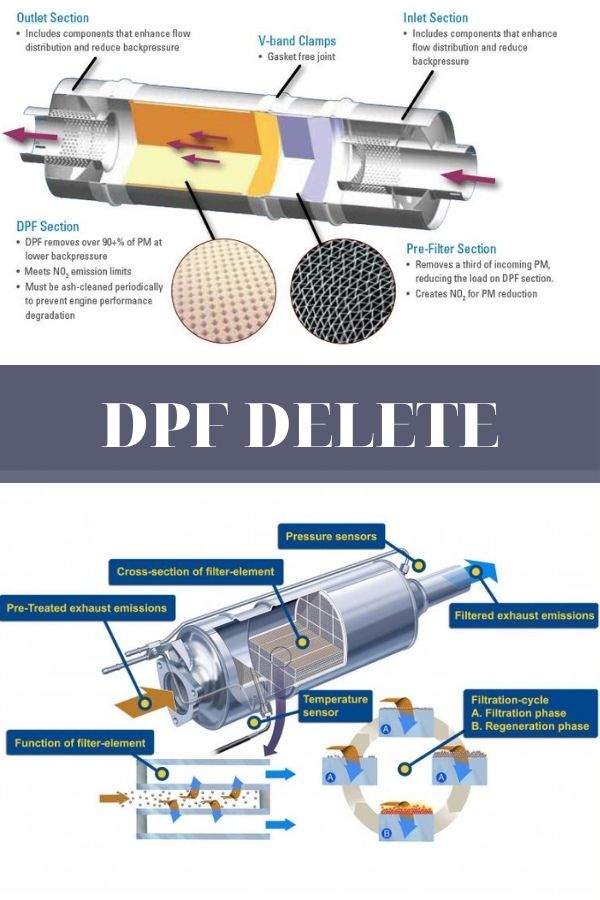
Diesel particulate filters (DPFs) are used in order to reduce harmful pollutants from diesel engine exhaust fumes. The accumulation of carbon deposits in engine lubrication oil is known as coking and can cause damage in fuel injectors by restricting fuel flow and clogging the engine oil filter. The DPF traps fuel particles in a layer of soot, allowing these to be burned off during periods of extended low-speed operation.
How does DPF help clean up exhaust fumes? Diesel particulate filters (DPFs) are used in order to reduce harmful pollutants from diesel engine exhaust fumes. The accumulation of carbon deposits in engine lubrication oil is known as coking and can cause damage in fuel injectors by restricting fuel flow and clogging the engine oil filter. The DPF traps fuel particles in a layer of soot, allowing these to be burned off during periods of extended low-speed operation.
What will happen if i press my dpf regeneration button too much?
This light will start flashing if your dpf regeneration system attempts to clean the filter, but it’s unable to burn away all of the soot during a single cycle. This means you must take action in order to reduce the number of exhaust fumes being sent into your truck. If you absolutely have to drive around with this light flashing, then try having the DPF reset done by a qualified diesel mechanic
How long does it take for my diesel particulate filter regeneration? The time will depend on how bad the soot buildup is inside of your vehicle’s DPF. It ranges between about 30 minutes and 1 hour
What are some symptoms that indicate i need to do my own dpf service?
Loss in fuel economy/power , reduced startup power, reduced idle RPM , damaged EGR passages, smoke from the exhaust, and a yellow or red glow on your dpf warning light
What can cause a dpf regeneration not to start? Your vehicle will first attempt a passive regeneration by allowing excess fuel into the filter. If this doesn’t work after an extended period of time (about 5 minutes), then it will try to burn off the soot using small amounts of excess oxygen through active regeneration. This process emits excessive soot particles which is one reason why you must be certain not to drive your truck around during any active cycle as doing so could damage your DPF!
How long have diesel trucks been using regenerative technology?
Regenerative emission control has been used on diesel truck engines since the late 1990’s.
What does a dpf warning light mean?
DPF warning lights are meant to activate before you’re at risk of damaging your vehicle, but that doesn’t always happen. For this reason, it is important that you know how to properly read and understand your vehicle’s display for both active and passive alert settings. If you see a flashing light after driving around for 15-20 minutes, then you must take action in order to begin reducing the number of exhaust fumes being sent into your engine!
Does a bad dpf cause low power / poor fuel economy? Yes, if not replaced or cleaned these devices can clog up over time. This will reduce the efficiency until eventually leading to complete failure of the part.
What does it mean when my dpf warning light is on? This means that your vehicle’s DPF filter has exceeded its maximum allowable temperature, which you are required to remedy for both environmental and safety reasons. You can usually fix this by driving at highway speeds for 15-20 minutes or more . It may take several regenerations before the light flashes if too much soot has accumulated in your truck’s exhaust system .
How many miles should i expect to get out of a diesel particulate filter ?
Diesel engines are generally engineered to go over 300k miles without any major repairs needed, but that doesn’t mean you should expect them fail every 50k miles . If they’re properly maintained then you should have no problem getting the full 300k miles out of your dpf without needing to replace it.
How to clean a Diesel Particulate Filter while driving ?
The Diesel Particulate Filter (DPF) is one of the most important components in modern diesel engines. It captures soot particles, which are then burnt when you next drive your car or truck. Over time, contaminants build up on these filter surfaces, reducing the filtration efficiency and causing eventual filter blockage. Removing this blockage is referred to as decoking, and can be done by carrying out several simple steps.
The first step is to simply stop driving your vehicle for a sufficient amount of time. This will give the DPF enough time to cool down after being heated up during normal driving conditions. It should be noted that if you are pulling a load, it is best not to stop for too long, as the load can shift and damage your vehicle.
Next, you will need to get a decoking tool from your local auto parts store. They have several different types on offer that work on specific makes of vehicles. You may also be able to find one at a trucking shop depending on your local area. These are normally battery-operated, with a long term that hooks into the exhaust system and heats up to around 1000 degrees Fahrenheit.
After decoking has finished, you may notice that there is an unpleasant smell coming from the exhaust of your vehicle. This is normal, but you should take your vehicle to a mechanic for a check-up to ensure that no problems have been caused.
You can also do this decoking process yourself with a DPF removal kit if the above is not available in your area.
Related Reading: 6.4 POWERSTROKE OWNERS: HOW TO SAVE YOUR ENGINE
Further Reading : Should I Delete My 6.7L Cummins?
